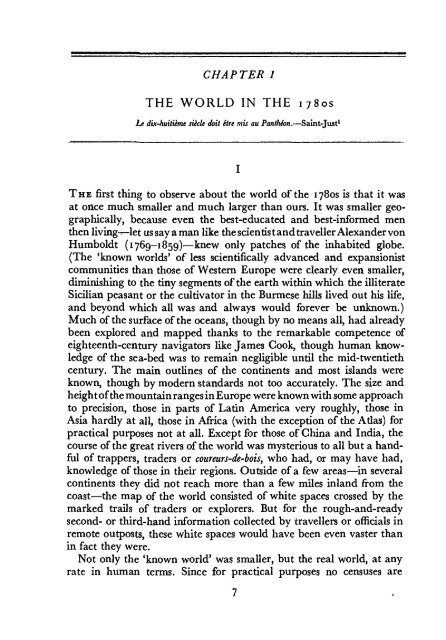- Page 1 and 2: The Age ofRevolutioni789-1848ERIC H
- Page 3: CONTENTSPREFACEINTRODUCTIONIXIPART
- Page 7 and 8: PREFACETHIS book traces the transfo
- Page 9 and 10: INTRODUCTIONWORDS are witnesses whi
- Page 11 and 12: INTRODUCTIONideology of an individu
- Page 13: Part IDEVELOPMENTS
- Page 17 and 18: THE WORLD IN THE 1780Sas is indicat
- Page 19 and 20: THE WORLD IN THE I780SIISuch as it
- Page 21 and 22: THE WORLD IN THE I 780Swhich it def
- Page 23 and 24: THE WORLD IN THE I 780Scoachmen, we
- Page 25 and 26: THE WORLD IN THE I 780Slegal depend
- Page 27 and 28: THE WORLD IN THE I 780Smined and op
- Page 29 and 30: THE WORLD IN THE I 780Smiddle class
- Page 31 and 32: TtTE WORLD IN THE I 78OS'planning';
- Page 33 and 34: THE WORLD IN THE1780SConflict betwe
- Page 36 and 37: THE AGE OF REVOLUTIONattached to it
- Page 38 and 39: THE AGE OF REVOLUTIONeminently Angl
- Page 40 and 41: THE AGE OF REVOLUTIONThe businessma
- Page 42 and 43: THE AGE OF REVOLUTIONthus gave the
- Page 44 and 45: THE AGE OF REVOLUTIONvided the othe
- Page 46 and 47: THE AGE OF REVOLUTIONpeople directl
- Page 48 and 49: THE AGE OF REVOLUTIONas a symptom o
- Page 50 and 51: THE AGE OF REVOLUTIONabolished unti
- Page 52 and 53: THE AGE OF REVOLUTIONto pull these
- Page 54 and 55: THE AGE OF REVOLUTION(which he paid
- Page 56 and 57: THE AGE OF REVOLUTIONproduce dispro
- Page 58 and 59: THE AGE OF REVOLUTIONstop. The answ
- Page 60 and 61: THE AGE OF REVOLUTIONconsumption wa
- Page 62 and 63: THE AGE OF REVOLUTIONThe later eigh
- Page 64 and 65:
THE AGE OF REVOLUTIONwidely propaga
- Page 66 and 67:
THE AGE OF REVOLUTIONreforms of 177
- Page 68 and 69:
THE AGE OF REVOLUTIONinstance that
- Page 70 and 71:
THE AGE OF REVOLUTIONfragments. All
- Page 72 and 73:
THE AGE OF REVOLUTIONthey achieved
- Page 74 and 75:
THE AOE OF REVOLUTIONhelp to solve
- Page 76 and 77:
THE AGE OF REVOLUTIONDanton, the ic
- Page 78 and 79:
THE AGE OF REVOLUTIONRepublic, whic
- Page 80 and 81:
THE AGE OF REVOLUTIONAustrians at F
- Page 82 and 83:
THE AGE OF REVOLUTIONone-third of t
- Page 84 and 85:
THE AGE OF REVOLUTIONwere Napoleoni
- Page 86 and 87:
THE AGE OF REVOLUTIONtroops defeate
- Page 88 and 89:
THE AGE OF REVOLUTIONfrom the bigot
- Page 90 and 91:
THE AGE OF REVOLUTIONto be annexed
- Page 92 and 93:
THE AGE OFREVOLUTIONtrouble; but th
- Page 94 and 95:
THE AGE OF REVOLUTIONmated by the R
- Page 96 and 97:
THE AOE OF REVOLUTIONIIIIn the cour
- Page 98 and 99:
THE AGE OF REVOLUTIONhad taken plac
- Page 100 and 101:
THE AGE OF REVOLUTIONwere gods upon
- Page 102 and 103:
THE AGE OF REVOLUTIONmay well have
- Page 104 and 105:
THE AGE OF REVOLUTIONlike William C
- Page 106 and 107:
THE AGE OF REVOLUTIONterms the Brit
- Page 108 and 109:
THE AGE OF REVOLUTIONagain: in the
- Page 110 and 111:
THE AGE OF REVOLUTIONPoland was dis
- Page 112 and 113:
THE AGE OF REVOLUTIONMonroe Declara
- Page 114 and 115:
THE AGE OF REVOLUTIONhaving a long
- Page 116 and 117:
THE AGE OF REVOLUTIONThough the rep
- Page 118 and 119:
THE AGE OF REVOLUTIONSpain in 1808
- Page 120 and 121:
THE AGE OF REVOLUTIONcrisis in the
- Page 122 and 123:
THE AGE OF REVOLUTIONIIIDuring the
- Page 124 and 125:
THE AGE OF REVOLUTIONtaneous intern
- Page 126 and 127:
THE AGE OF REVOLUTIONlived under st
- Page 128 and 129:
THE AGE OF REVOLUTIONmoderate refor
- Page 130 and 131:
THE AGE OF REVOLUTIONmost formidabl
- Page 132 and 133:
THE AGE OFREVOLUTIONi.e. those grou
- Page 134 and 135:
THE AGE OF REVOLUTIONthey doubted t
- Page 136 and 137:
THE AGE OF REVOLUTIONas before, of
- Page 138 and 139:
THE AGE OF REVOLUTIONaccepting the
- Page 140 and 141:
CHAPTER 7NATIONALISMEvery people ha
- Page 142 and 143:
THE AOE OF REVOLUTIONgenerosity. On
- Page 144 and 145:
THE AOE OF REVOLUTIONthe national l
- Page 146 and 147:
THE AGE OF REVOLUTIONthough it did
- Page 148 and 149:
THE AGE OF REVOLUTIONthe Serbian de
- Page 150 and 151:
THE AGE OF REVOLUTIONpeasant's wron
- Page 152 and 153:
THE AGE OFREVOLUTIONor firm (a situ
- Page 155:
Part IIRESULTS
- Page 158 and 159:
THE AOE OF REVOLUTIONreason, i.e. e
- Page 160 and 161:
THE AGE OF REVOLUTIONvast bulk of t
- Page 162 and 163:
THE AGE OF REVOLUTIONowners who wer
- Page 164 and 165:
THE AGE OF REVOLUTIONrational econo
- Page 166 and 167:
THE AGE OF REVOLUTIONmore regard fo
- Page 168 and 169:
THE AGE OF REVOLUTIONtion had not g
- Page 170 and 171:
THE AGE OF REVOLUTIONBritish landlo
- Page 172 and 173:
THE AGE OFREVOLUTIONnew officials o
- Page 174 and 175:
THE AGE OP REVOLUTIONrecently by th
- Page 176 and 177:
CHAPTER 9TOWARDS AN INDUSTRIAL WORL
- Page 178 and 179:
THE AGE OF REVOLUTIONduring our per
- Page 180 and 181:
THE AGE OF REVOLUTIONgoods already
- Page 182 and 183:
THE AGE OF REVOLUTIONthe intermedia
- Page 184 and 185:
THE AGE OF REVOLUTIONand paternal,
- Page 186 and 187:
THE AGE OF REVOLUTIONindustrial pow
- Page 188 and 189:
THE AGE OF REVOLUTIONRussian Poland
- Page 190 and 191:
tsCHAPTERlOTHE CAREER OPEN TO TALEN
- Page 192 and 193:
THE AGE OF REVOLUTIONlooked at the
- Page 194 and 195:
THE AGE OF REVOLUTIONferocious and
- Page 196 and 197:
THE AGE OF REVOLUTIONcontrolled the
- Page 198 and 199:
THE AGE OF REVOLUTIONpublic rewards
- Page 200 and 201:
THE AGE OF REVOLUTIONitism. In soci
- Page 202 and 203:
THE AOE OF REVOLUTIONon or held the
- Page 204 and 205:
THE AGE OF REVOLUTIONdrunken unbeli
- Page 206 and 207:
THE AOE OF REVOLUTIONhad not shown
- Page 208 and 209:
CHAPTER 11THE LABOURING POOREvery m
- Page 210 and 211:
THE AGE OF REVOLUTIONthem, because
- Page 212 and 213:
THE AGE OF REVOLUTIONthe powers-tha
- Page 214 and 215:
THE AOE OF REVOLUTIONless passively
- Page 216 and 217:
THE AGE OF REVOLUTIONMaterially the
- Page 218 and 219:
THE AGE OF REVOLUTIONworking class
- Page 220 and 221:
THE AGE OF REVOLUTIONsingle but dec
- Page 222 and 223:
THE AGE OF REVOLUTION400 newsrooms.
- Page 224 and 225:
THE AGE OF REVOLUTIONconstant of ou
- Page 226 and 227:
THE AGE OF REVOLUTIONlike all their
- Page 228 and 229:
THE AGE OF REVOLUTIONthat of the tw
- Page 230 and 231:
THE AGE OF REVOLUTIONestablished re
- Page 232 and 233:
THE AGE OF REVOLUTIONtures. 4 " At
- Page 234 and 235:
THE AGE OF REVOLUTIONmost three-qua
- Page 236 and 237:
THE AGE OF REVOLUTIONOnly among the
- Page 238 and 239:
THE AGE OF REVOLUTIONthe Spaniards,
- Page 240 and 241:
THE AGE OF REVOLUTION(1801-1890). T
- Page 242 and 243:
CHAPTER 13IDEOLOGY: SECULAR{Mr Bent
- Page 244 and 245:
THE AGE OF REVOLUTIONsuch irreducib
- Page 246 and 247:
THE AGE OF REVOLUTIONboth Britain a
- Page 248 and 249:
THE AGE OF REVOLUTIONthe masses,* a
- Page 250 and 251:
THE AOE OFREVOLUTIONseparate the pu
- Page 252 and 253:
THE AGE OF REVOLUTIONIn the second
- Page 254 and 255:
THE AGE OF REVOLUTIONmodest than th
- Page 256 and 257:
THE AGE OF REVOLUTIONproletarians.
- Page 258 and 259:
THE AGE OF REVOLUTIONGerman literat
- Page 260 and 261:
THE AGE OF REVOLUTIONcontradiction
- Page 262 and 263:
THE AGE OFREVOLUTIONby Goethe, Schi
- Page 264 and 265:
THE AGE OF REVOLUTIONThat artists w
- Page 266 and 267:
THE AGE OF REVOLUTIONthemselves har
- Page 268 and 269:
THE AGE OF REVOLUTIONwhich provided
- Page 270 and 271:
THE AGE OF REVOLUTIONarts* and the
- Page 272 and 273:
THE AGE OFREVOLUTIONit seemed evide
- Page 274 and 275:
THE AGE OF REVOLUTIONyet enslaved b
- Page 276 and 277:
THE AGE OF REVOLUTIONstandards be r
- Page 278 and 279:
THE AGE OF REVOLUTIONlater became s
- Page 280 and 281:
THE AGE OF REVOLUTIONmodest provinc
- Page 282 and 283:
THE AGE OP REVOLUTIONwould be direc
- Page 284 and 285:
THE AGE OF REVOLUTIONof the popular
- Page 286 and 287:
THE AGE OF REVOLUTIONscience is not
- Page 288 and 289:
THE AGE OF REVOLUTIONas in France a
- Page 290 and 291:
THE AGE OF REVOLUTIONDal ton 1803-1
- Page 292 and 293:
THE AGE OF REVOLUTIONFrance, Italy,
- Page 294 and 295:
THE AGE OF REVOLUTIONmany, which wa
- Page 296 and 297:
THE AGE OF REVOLUTIONthese gained g
- Page 298 and 299:
THE AGE OF REVOLUTIONexcept politic
- Page 300 and 301:
THE AGE OF REVOLUTIONof gas-lightin
- Page 302 and 303:
THE AGE OF REVOLUTIONCalvinist, ins
- Page 304 and 305:
THE AGE OF REVOLUTION'romantic' app
- Page 306 and 307:
THE AGE OF REVOLUTIONbeen more wide
- Page 308 and 309:
THE AGE OF REVOLUTIONmales after 18
- Page 310 and 311:
THE AGE OF REVOLUTIONwere no doubt
- Page 312 and 313:
THE AGE OF REVOLUTIONmovement, it w
- Page 314 and 315:
THE AGE OF REVOLUTIONrivalries peac
- Page 316:
THE AGE OF REVOLUTIONuniversal and
- Page 320 and 321:
• Bombay• ShanghaiHANKOW. rffia
- Page 322 and 323:
NAMETHE STATES OF EUROPE IN 1836TOT
- Page 324 and 325:
INDUSTRIALISATIONof EUROPE 185OV///
- Page 326 and 327:
NOTESCHAPTER i: THE WORLD IN THB I
- Page 328 and 329:
NOTES23 Baines, op. cit., p. 356.24
- Page 330 and 331:
NOTES14 cf. E. J. Hobsbawm, Primiti
- Page 332 and 333:
6 Mulhall, op. cit., Post Office.7
- Page 334 and 335:
NOTES20 Quoted in A. E. Musson, The
- Page 336 and 337:
NOTES17 Ibid. pp. 243, 246, 251.18
- Page 338 and 339:
BIBLIOGRAPHYUsher, Economic history
- Page 340 and 341:
BIBLIOGRAPHYuseful. E. HaIeVy, The
- Page 342 and 343:
BIBLIOGRAPHYby F. Crouzet's massive
- Page 344 and 345:
INDEXAbd-el-Kader, Algerian leader,
- Page 346 and 347:
Breslau, 290Brest, 183Bright, John,
- Page 348 and 349:
Croatian Gazette, see Illyrian Nati
- Page 350 and 351:
INDEXFriedland, battle of, 87Friedr
- Page 352 and 353:
INDEXIreland, Irish, 10, II, 15, 17
- Page 354 and 355:
INDEXMadeleine, la, 184, 361Madison
- Page 356 and 357:
INDEXOrthodox Church, 104, 137, 140
- Page 358 and 359:
INDEXRome, Roman, 8, 15, 44, 64, 82
- Page 360 and 361:
INDEXTerror, the, 67-72, 79; see al



